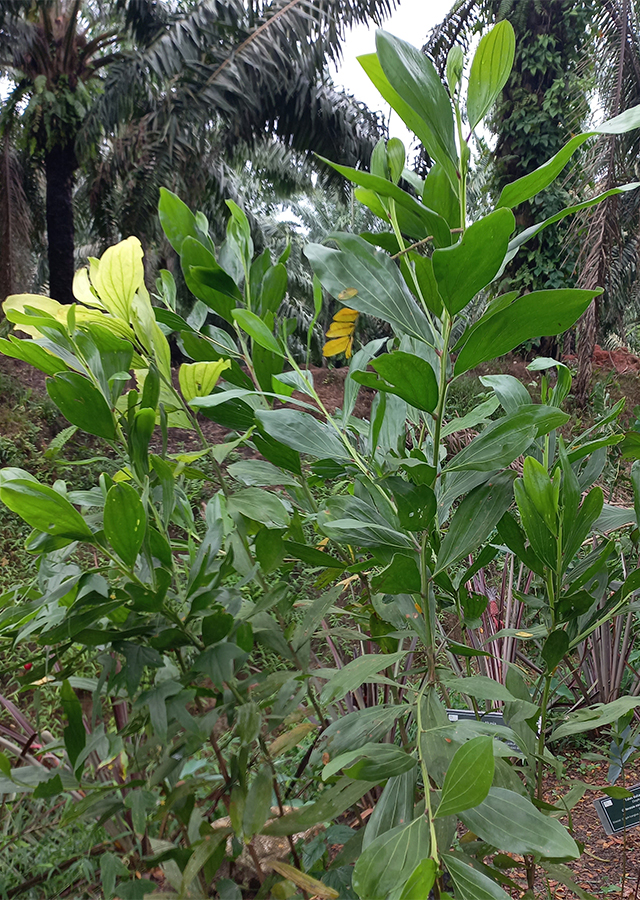Traditional Herbs from Acacia mangium
overcome_premature_ejaculation
- Wash enough fresh acacia leaves.
- Boil the leaves until boiling.
- Strain the boiled product.
- Drink while it's warm.
reduce_hypertension
- Prepare enough acacia leaves.
- Wash until clean.
- Boil with enough water to boil.
- Strain and drink while warm.
What is Acacia mangium Looks like??



Parts of Acacia mangium that could be used
- Leaves
- Bark
Acacia mangium Distribution
Acacia originates from Australia, Indonesia and Papua New Guinea, and was successfully introduced to Sabah, Malaysia in 1960 and other countries, such as Bangladesh, China, Thailand, India, the Philippines, Sri Lanka and India. Acacia plants are widely used as road shade plants, ornamental plants, and the wood is used in making household furniture. Acacia trees also have several biochemical contents that are useful for curing disease disorders.Agroecology of Acacia mangium
Plants in warm humid tropical areas, found at altitudes of up to 800 m above sea level, in areas where the average annual rainfall is in the range of 1,500-3,000 mm. Succeeds in a wide range of soil types, usually found in acidic soils with moderate to low fertility, prefers well-drained soil, pH in the 4.5-6.5 range, requires a sunny position (full sun).
Morphology of Acacia mangium
- Acacia roots are strong and sturdy.
- Young acacia stems have smooth, greenish bark. After 2-3 years of age, cracks will appear in the tree bark. On older trees, the bark will have a rough texture , hard, slit near the base and the color changes to brown or dark brown.
- The leaves on newly germinated acacia seedlings are compound leaves consisting of many leaflets. However, after a few weeks, the leaves become compound will not form and the petiole and main axis of each compound leaf will grow wider and turn into a phyllode which has a parallel vein shape and reaches a length of 25 cm and a width of 10 cm.
- Acacia flowers are composed of many small white or cream flowers. like spikes. When blooming, the flower shape resembles a bottle brush.
- The pods are wide, linear, and irregularly circular when ripe, membranous or slightly woody, inconspicuously veined, 3-5 mm wide and long 7-10 cm. reddish.
Cultivation of Acacia mangium
- Generative propagation with seeds from seeds that are first treated by soaking in boiled water which is allowed to cool for 24 hours, or by soaking in sulfuric acid for 10-30 minutes followed by soaking in cold water for 24 hours.
- Vegetative propagation by stem cuttings from one segment with a length of 4-5 cm and a diameter of 0.5-1.5 cm, leaving 0.5-1 phyllodes and grafting.
Acacia mangium, more details :
Chemical Content of Acacia mangiumAlkaloids, flavonoids, phenolics, steroids, tannins, terpenoids, methoxyl, uronic acid, 4-0-methylgucoronic acid, glucoronic acid, galactose, arabinose, and rhamnose.
Benefits of Acacia mangium
Treats diarrhea and dysentery, helps in cases of internal bleeding, treats wounds and other skin problems, hemorrhoids, sweaty feet, some eye problems, as a mouthwash, treats premature ejaculation, and reduces hypertension.
Simplisia of Acacia mangium
Another Facts for Acacia mangium :
Synonym of Acacia mangiumMangium montanum Rumph., Racosperma mangium (Willd.) Pedley, Acacia holosericea A.Cunn.
Habitus of Acacia mangium
Tree. Annual tree reaches 25-35 m in height
Habitat of Acacia mangium
- Riverside", "Forest", "Shrub Area", "Grassland", "Land
No comments:
Post a Comment